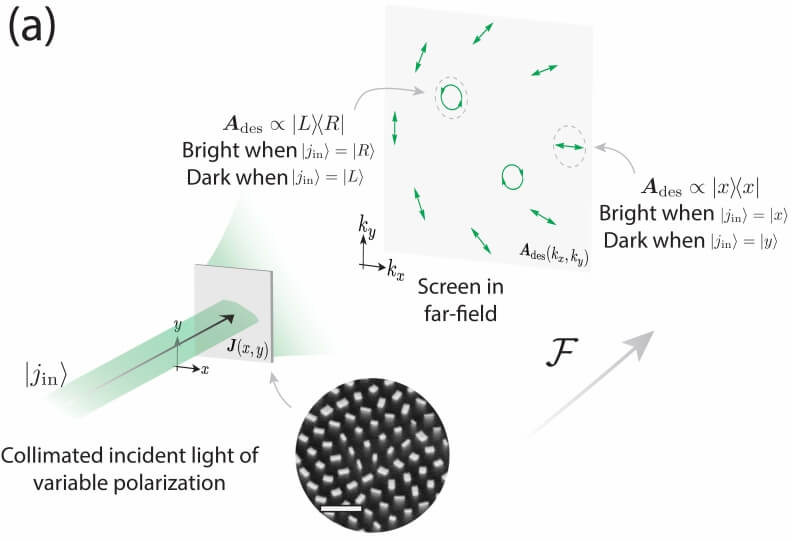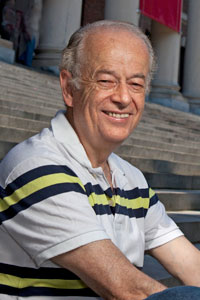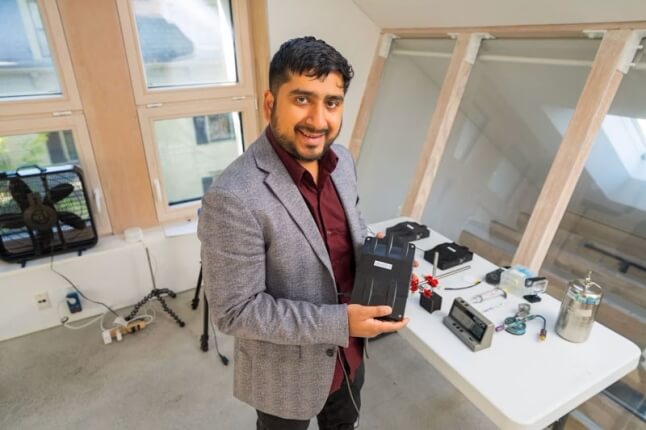News
Illustrative example of a polarization-analyzing hologram. When illuminated with a laser light, the metasurface hologram implements a far-field in which light is directed on the basis of its incident polarization state. In this particular example, the hologram is designed to produce a pattern of illustrations of different polarization states. (Image credit: Capasso Lab/Harvard SEAS)
Download Image
For years, researchers at the Harvard John A. Paulson School of Engineering and Applied Sciences (SEAS) have engineered metasurfaces to manipulate light based on its polarization state. That research has contributed to advances in polarization technology — but metasurface technology has proven more powerful than even the researchers themselves realized.
Now, researchers have uncovered hidden potential in these metasurfaces and, in a new paper, demonstrated optical devices that manipulate light's polarization state with an unprecedented degree of control.
“This research shows that the ability to switch between holographic images that need not be limited to just two polarization states,” said Federico Capasso, the Robert L. Wallace Professor of Applied Physics and Vinton Hayes Senior Research Fellow in Electrical Engineering at SEAS and senior author of the paper. “Our new metasurface can encode an unlimited number of holographic images or manipulate light in virtually infinite number of directions based on a very large number of polarization states.”
The research, published in Science Advances, demonstrates a new way to control polarized light with metasurfaces. This new approach – in which the researchers can engineer a holographic image with a polarization-tunable response across the image itself – could lead to applications in diverse fields including imaging, microscopes, displays, and even astronomy.
When illuminated with a laser light, the metasurface hologram implements a far-field in which light is directed on the basis of its incident polarization state. Here, the far-field measured on a digital image sensor reflects this desired behavior for six incident polarization states. (Image credit: Capasso Lab/Harvard SEAS)
Download Image
“This advancement is general and could be applied to almost any kind of optical system that uses polarized light,” said Noah Rubin, a postdoctoral fellow at SEAS and first author of the paper. “Specifically, this suggests that metasurfaces could be used in new types of laser systems whose output light could be engineered based on light’s polarization state, or perhaps even in telescope systems where similar types of optics are already being used to aid in the detection of Earth-like exoplanets.”
“Holography has always been a popular technique to record and display information,” said Aun Zaidi, a graduate student at SEAS and co-lead author of the paper. “We have taken a fundamental principle of holography and generalized it in a way that greatly expands the information capacity of this rather old technique.”
Next, the researchers aim to understand these devices better, including how they could be used in real-world applications.
The Harvard Office of Technology Development has protected the intellectual property relating to this project and is exploring commercialization opportunities.
The research was co-authored by Ahmed Dorrah and Zhujun Shi. It was supported by the National Science Foundation under grant no. DGE1144152 and 1541959 and the Air Force Office of Scientific Research under grant no. FA9550-19-1-0135.
Topics: Applied Physics
Cutting-edge science delivered direct to your inbox.
Join the Harvard SEAS mailing list.
Scientist Profiles
Federico Capasso
Robert L. Wallace Professor of Applied Physics and Vinton Hayes Senior Research Fellow in Electrical Engineering
Press Contact
Leah Burrows | 617-496-1351 | lburrows@seas.harvard.edu





